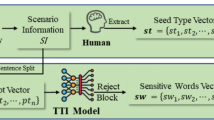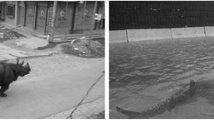Abstract
As User Generated Content takes up an increasing share of the total Internet multimedia traffic, it becomes increasingly important to protect users (be they consumers or professionals, such as journalists) from potentially traumatizing content that is accessible on the web. In this demonstration, we present a web service that can identify disturbing or graphic content in images. The service can be used by platforms for filtering or to warn users prior to exposing them to such content. We evaluate the performance of the service and propose solutions towards extending the training dataset and thus further improving the performance of the service, while minimizing emotional distress to human annotators.
Access this chapter
Tax calculation will be finalised at checkout
Purchases are for personal use only
Similar content being viewed by others
Notes
- 1.
Also see http://dartcenter.org/.
- 2.
Downloaded from http://caffe.berkeleyvision.org/model_zoo.html.
- 3.
The demo is available at http://reveal-mklab.iti.gr/reveal/disturbing/.
References
Déniz, O., Serrano, I., et al.: Fast violence detection in video. In: Battiato, S., Braz, J. (eds.) VISAPP 2014, vol. 2, pp. 478–485. SciTePress, Setúbal (2014)
Dubberley, S., Griffin, E., Bal, H.M.: Making secondary trauma a primary issue: a study of eyewitness media and vicarious trauma on the digital frontline (2015). http://eyewitnessmediahub.com/uploads/browser/files/Trauma%20Report.pdf
Jia, Y., Shelhamer, E., et al.: Caffe: convolutional architecture for fast feature embedding. arXiv preprint arXiv:1408.5093 (2014)
Krizhevsky, A., Sutskever, I., Hinton, G.E.: Imagenet classification with deep convolutional neural networks. In: NIPS 2012, pp. 1097–1105 (2012)
Li, B., Xiong, W., et al.: Horror image recognition based on context-aware multi-instance learning. IEEE Trans. Image Process. 24, 5193–5205 (2015)
Schaefer, G., Stich, M.: UCID: an uncompressed color image database. In: Storage and Retrieval Methods and Applications for Multimedia, vol. 5307, pp. 472–480. SPIE (2004)
Sjberg, M., Ionescu, B., et al.: The MediaEval 2014 affect task: violent scenes detection. In: MediaEval (2014)
Wang, D., Zhang, Z., Wang, W., Wang, L., Tan, T.: Baseline results for violence detection in still images. In: AVSS, pp. 54–57 (2012)
Acknowledgements
This work is supported by the REVEAL and InVID projects, partially funded by the European Commission under contract numbers 610928 and 687786. In addition, we would like to acknowledge the support that NVIDIA provided us through the GPU Grant Program.
Author information
Authors and Affiliations
Corresponding author
Editor information
Editors and Affiliations
Rights and permissions
Copyright information
© 2017 Springer International Publishing AG
About this paper
Cite this paper
Zampoglou, M., Papadopoulos, S., Kompatsiaris, Y., Spangenberg, J. (2017). A Web-Based Service for Disturbing Image Detection. In: Amsaleg, L., Guðmundsson, G., Gurrin, C., Jónsson, B., Satoh, S. (eds) MultiMedia Modeling. MMM 2017. Lecture Notes in Computer Science(), vol 10133. Springer, Cham. https://doi.org/10.1007/978-3-319-51814-5_37
Download citation
DOI: https://doi.org/10.1007/978-3-319-51814-5_37
Published:
Publisher Name: Springer, Cham
Print ISBN: 978-3-319-51813-8
Online ISBN: 978-3-319-51814-5
eBook Packages: Computer ScienceComputer Science (R0)




